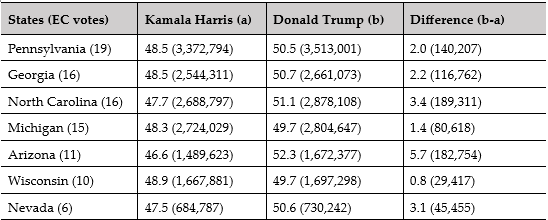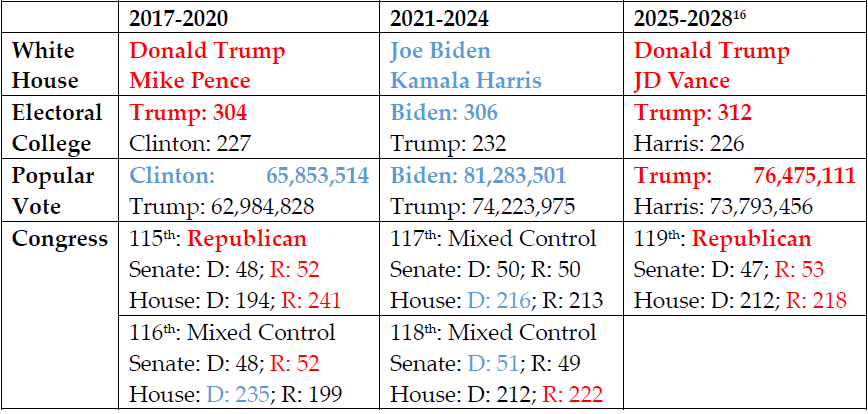Introduction
On November 5, 2024, Donald J. Trump was re-elected to serve as the 47th president of the United States of America. Having won all seven key battleground states in the Electoral College as well as the popular vote, President-elect Trump will assume office with an even stronger mandate to govern than he had in 2016. This time he will also be backed by a governing trifecta with Republican control of the 119th Congress in both the House of Representatives and Senate as well as a supermajority on the U.S. Supreme Court. The next four years will once more be a rollercoaster in American politics. The Republic of Korea (ROK) must seek effective measures to prepare for President-elect Trump’s second term given there will be limited legislative or judicial constraints on his executive authority. In short, President Trump’s foreign and defense policies this time could be unstoppable and unpredictable. What should U.S. allies make of the unprecedented 2024 U.S. elections? How might President Trump deal with friends and foes this time?
This Asan Issue Brief provides an overview of the 2024 U.S. elections and the outlook for U.S. allies, with a focus on the view from Seoul. The Issue Brief proceeds as follows. First, it reviews the 2024 U.S. election results and looks at how public opinion surveys performed in predicting the final outcome. Second, it introduces key changes in the 119th Congress as they relate to the Korean Peninsula. Third, it canvasses the Trump administration’s expected ROK-U.S. alliance agenda. Finally, it discusses how the Yoon administration can engage the Trump administration in terms of defense cost-sharing, burden-sharing on shipbuilding, and collective bargaining with other allies.
1. The Presidential Election Results Explained
The 2024 election campaign and results saw many ‘firsts.’ It began with President Joe Biden’s dramatic decision not to seek re-election following the first debate with former President Trump in June 2024, making him only the second U.S. president in history to do so after Lyndon Johnson in 1968. This was followed by the shocking assassination attempt on President Trump during a campaign rally and President Biden’s sudden handover to Vice President Kamala Harris who ran a 100-day campaign. The election also became the most expensive presidential election ever, with an estimated $15.9 billion in spending on all federal races, nearly double what 2016 cost.1
Most commentators therefore expected the 2024 U.S. presidential election to be a tight race. Right before the election, Electoral College forecasts showed that 82 electoral votes remained undecided while other prediction models in FiveThirtyEight and The Economist also suggested that the election would be essentially a toss-up.2 Pre-election polls consistently suggested that this would be the tightest race in history, such as when Republican Rutherford B. Hayes beat Democrat Samuel J. Tilden by one electoral vote in 1876 and even in 2000, when Republican George W. Bush defeated Democrat Al Gore by the comparably comfortable margin of 271 to 267.3 Numerous national polls showed a narrowing gap between the two candidates as the election entered its final weeks. The seven battleground states in 2024 were Wisconsin and Michigan in the Midwest, Pennsylvania in the northeastern industrial heartland, North Carolina and Georgia in the southeast, and Arizona and Nevada in the west. Meanwhile, prominent election forecasters such as Professor Allan Lichtman, who had correctly predicted 10 of the past 11 U.S. presidential elections, also predicted that Vice President Kamala Harris would win the election.4
In the end, President Trump won all seven battleground states to secure the necessary 270 Electoral College votes and ultimately win 312 votes. He also won the popular vote by about 2 percentage points (50.1% vs. Harris 48.3%).5 The Electoral College win was far larger than the 22,000 votes across three states that President Biden narrowly won by in 2020 though nowhere near as comprehensive as Republican Ronald Reagan’s 49-state victory over Democrat Walter Mondale in 1984, when President Reagan won by 525 Electoral College votes and 58.8% of the popular vote. The voter turnout in 2024 reached 65%, the second highest in the past century, which did not surpass the record in 2020 with 66%, but the early voting in key states such as Michigan and Georgia was notable.6 While Vice President Harris became the twelfth incumbent party candidate to lose a bid for a second term, President Trump set a new record by winning 312 Electoral College votes for the first time since 2012.
Table 1 shows how tight the election was in those seven states in contrast to the results of the Electoral College votes. As with other U.S. elections, the overall difference in votes reported so far in the swing states was less than 800,000. Ultimately, a relatively small number of votes determined the election. The winning margins of President Trump were less than 4 percentage points, except in states like Arizona. In Pennsylvania, President Biden won in 2020 by a very slim of fewer than 50,000 votes.7 But in 2024, President Trump won the state by about 140,000 votes out of seven million votes cast and this helped him secure 19 electoral votes as a major victory. In Georgia, President Biden only won by a little under 12,000 votes in 2020. President Trump surprisingly received about 110,000 more votes and secured 16 electoral votes.
Table 1. U.S. Presidential Election Results in Swing States (%, Number of Votes)

In North Carolina, which the Democrats have not won since 2008, several polls showed a smaller Trump lead than in Arizona and Georgia.8 In 2016, President Trump defeated President Biden by just about one percent, 74,000 votes, but this year, he won the state by 190,000 more votes. Michigan was more likely to go to Democrats judging from the past, but President Trump won in 2016 by a slim 0.2 percentage point.9 In 2020, the state was President Biden’s biggest win among the swing states, and in 2024, Trump ultimately won by less than 90,000 votes. In Arizona, border crossings and immigration have been the hottest debate and the 2020 election was just the second that the Democrats had won since the 1940s.10 In 2024, President Trump was successful in securing a little over 180,000 more votes. Nevada has been a blue state since 2008, but some polls suggested that it was competitive in 2024.11 Finally, President Trump won by about 50,000 votes in 2024. Also, in Wisconsin, President Trump by less than a 1 percentage point margin with less than 30,000 votes. Interestingly, though voters in Arizona and Nevada approved an abortion rights amendment, the same voters cast more votes for President Trump.12
Overall, public concern over the state of the national economy appeared to be a main driver for voters who supported President Trump. As the exit polls suggested, many voters cited the economy as a top priority when they headed to the polling booth.13 It was expected that President Trump would do a better job in dealing with economic problems than Vice President Harris, and low approval for the Biden administration was largely due to high inflation. As the voters have previously sought change in a presidential election when they are dissatisfied with the economy,14 a poor performance by the Biden administration on the economy seems to have translated into votes for President Trump.
2. The Congressional Elections
In addition to the presidential election, the U.S. Congressional elections were held to elect all 435 members in the House of Representatives and 33 out of 100 Senate seats. The Republican Party won the necessary 218 seats to retain a majority. It also regained control of the Senate with crucial wins in Ohio, West Virginia, and Nebraska to have a 53-seat majority.15 As Table 2 shows, the election outcomes in the Senate and the House will give President Trump a governing trifecta, much like during the start of his first term in office. In the Senate, the retirement of long-time Senate Republican leader Mitch McConnell (R-Kentucky) paved the way for his deputy Senator John Thune (R-South Dakota) to take the reins for the Republican majority, overseeing key personnel confirmations. Meanwhile, in the House, Speaker Mike Johnson (R-Louisiana) continues in his position, especially given the acrimonious nominating process that preceded his election with the House Republican Freedom Caucus.
Table 2. Electoral College, Popular Vote, and Congressional Balance

In terms of ROK-U.S. relations and particularly the Korea Caucuses in both the House and Senate, there is expected to be continuity of membership in both. In the Senate, none of the four Senators who launched the Korea Caucus in 2023 were up for re-election, including Senators Jon Ossoff (D-Georgia), Dan Sullivan (R-Alaska), Brian Schatz (D-Hawaii), and Todd Young (R-Indiana). In the House, one significant change has been Representative Andy Kim (D-New Jersey) who won pre-selection to contest the Senate seat and successfully won the election, becoming the first American senator of Korean heritage. In addition to his membership on the House Korea Caucus, Senator-elect Kim had served on the House Armed Services Committee as well as the House Foreign Affairs Committee.17
Also in the House of relevance to Korea-U.S. relations, Representative Young Kim (R-California), who chaired the House Foreign Affairs Subcommittee on the Indo-Pacific, won re-election. Representative Michelle Park Steel (R-California), whose foreign policy roles included the Select Committee on Strategic Competition between the United States and the Chinese Communist Party, was in a tight race with the outcome undeclared when this Issue Brief went to publication on November 19. Re-elected on the Democratic side was Representative Marilyn Strickland (D-Washington) who had served on the House Armed Services Committee. In sum, most of the key Congressional representatives in both the House and Senate who advocate on behalf of the ROK-U.S. alliance will return to office.
3. President Trump’s ROK-U.S. Alliance Priorities
The United States’ 51 treaty allies around the world will once again face a Trump administration that has pledged to put ‘America First’ in its approach to alliances. Allied governments may have learned lessons from their first experience dealing with the Trump administration from 2017-2020, but many of their leaders are no longer in office while the leaders of adversaries are all still in power. The world has also changed markedly from the days of the COVID-19 pandemic when President Trump left office. It is now engulfed in bloody conflicts that have claimed hundreds of thousands of lives in Ukraine, the Middle East, Africa, and Myanmar. Meanwhile, authoritarian regimes like North Korea, China, Russia, and Iran have moved from opportunistic cooperation to de facto military alliances.
Who President Trump chooses to serve in his administration will have enormous consequences given the high turnover and personnel crises that plagued his first term. While he has announced a series of cabinet picks in quick succession in the two weeks since his victory, it remains to be seen which of these nominees will ultimately pass Senate confirmation when the 119th Congress sits, or whether they will be made as recess appointments or without Senate hearings as President Trump has proposed.
The day before the U.S. elections, the ROK presidential office emphasized that “the government is ready to respond to any outcome in the U.S. presidential election.”18 There will inevitably be concern about how President Trump will approach the North Korean nuclear issue and whether he will continue the Biden administration’s efforts to strengthen extended nuclear deterrence assurances to the ROK through the Nuclear Consultative Group (NCG). President Trump’s ‘all or nothing’ DPRK strategy failed in the 2019 Hanoi Summit and he has subsequently downplayed the danger posed by Kim Jong Un. Nevertheless, as North Korea and Russia are strengthening their ties and President Trump has been touting his cordial relations with strongmen as evidence of his statesmanship, he may engage Kim Jong Un just as he has promised to deal with Russian President Vladimir Putin to end the war in Ukraine.
The second major priority that the ROK should be ready for is President Trump’s almost certain attack on the recently concluded Special Measures Agreement (SMA). As the ROK’s economic and defense power started to grow throughout the years, the United States shifted from fully bearing the cost of stationing United States Forces Korea (USFK) to negotiating the ROK’s contribution to some of the costs. The first Trump administration demanded a five-fold increase in cost-sharing, and there has been continuous renegotiation between the two countries. On October 4, the Yoon administration concluded the 12th SMA with the Biden administration ahead of schedule as a five-year deal from 2026-2030 with an 8.3% increase.19 However, the SMA is an executive agreement that the president can overturn. President Trump said at the Economic Club of Chicago on October 15 that the ROK is ‘a money machine,’ and also argued that the ROK would be paying $10 billion a year if he was in the White House.20
4. The Trump Alliance Burden-sharing Dilemma
The allied burden-sharing dilemma that the United States has long faced between encouraging greater allied self-reliance and maintaining dominant influence over its allies has shifted in favor of the former under President Trump.21 Allies that have repeatedly drawn his ire will not only be expected to do more for their own defense, but also financially contribute towards the collective defense that the United States military underwrites. For the ROK, this will require putting the SMA back on the negotiating table.
Yet it is also important to impress upon President Trump that the U.S. military presence in the ROK is not, as he often portrays, a protection racket for which the U.S. is not properly paid or receives no benefit. The U.S. military commitment to the ROK actually magnifies American power in many ways. The 28,500 U.S. troops and their families based in the ROK—and not the erroneous 40,000 troops that President Trump has recently mentioned to inflate the size of the U.S. commitment—are the most tangible demonstration of the U.S. security commitment to its allies. More importantly, their presence has also deterred North Korea, China, and Russia from starting another all-out war in Northeast Asia for over 70 years, a war that the United States would almost certainly find itself involved in at far greater cost and sacrifice.
The ROK-U.S. alliance is also a unique combined forces command in partnership with almost 500,000 ROK forces as well as U.S. leadership of the 18-member United Nations Command that is unlike its other alliances in the Indo-Pacific. The alliance is also becoming a ‘global comprehensive strategic alliance’ whereby the ROK is stepping up to support U.S. efforts beyond the Korean Peninsula in a new form of burden-sharing.22 The U.S. military presence has also constrained ROK debates about nuclear armament that would surely follow a U.S. troop withdrawal. And even from a strictly transactional perspective, it is unclear how much money the United States would actually save by relocating its forces and their dependents to the continental United States given it would need to build new bases and facilities or instead consider a reduction in the size of the U.S. armed forces.23
Nonetheless, the Yoon administration will need more bargaining chips than just more cost-sharing offers or appeals to U.S. self-interest. For example, the Moon administration also revisited the Korea-U.S. Free Trade Agreement in 2017-18 to grant more U.S. access to the ROK automobile market and negotiated an alternative steel export quota regime in response to President Trump’s 25% steel tariff. This time, the ROK will need to demonstrate what more it can contribute when it comes to the bipartisan U.S. desire to attract significant ROK corporate investment in U.S. manufacturing. After all, attracting $200 billion in Asian corporate investment was one of President Biden’s proudest achievements, of which the ROK was the largest investor in 2023 alone at $21.5 billion and far more over the past four years.24
It was therefore noteworthy that President Trump’s first phone call with President Yoon explicitly discussed shipbuilding as an area for close cooperation.25 This builds on the promising start under the Biden administration to engage ROK shipbuilders to support U.S. naval shipbuilding and sustainment requirements, including through the maintenance, repair, and overhaul (MRO) of forward-deployed U.S. Navy supply ships. President Trump’s commitment to rebuilding U.S. military strength is coupled with an intense urgency about an imminent crisis with China expressed by many of his advisors and senior officials. This can be an opportunity for the ROK to demonstrate how it can help keep existing U.S. military capabilities in service longer through in-theatre sustainment while the U.S. defense industrial base gets back on schedule with its major capability acquisitions.26
Finally, the ROK will need to work closely with other U.S. allies around the world. The major bilateral priorities—cost-sharing and force posture, threat prioritization and risk tolerance, industrial policy and trade access, nuclear deterrence, shipbuilding, and defense industrial base support—are not solely ROK-U.S. issues. These priorities will have familiar echoes whether it is in Seoul or Tokyo, Canberra or Manila, Brussels or Berlin, Riyadh or Jerusalem. The Biden administration’s final alliance gift may therefore be the stronger linkages that it has fostered among allies and partners across regions, from the NATO IP4 meetings to the AUKUS partnership, which will now be called upon to build guardrails for U.S. global leadership.
Conclusion
In his 2015 election manifesto, Crippled America: How to Make America Great Again, President Trump asked, “If other countries are depending on us to protect them, shouldn’t they be willing to make sure we have the capability to do it? Shouldn’t they be willing to pay for the servicemen and servicewomen and the equipment we’re providing?27 A decade on as he prepares for his second term in office, President Trump’s attitude towards allies in general, and especially the ‘money machine’ allies hosting U.S. troops, has only hardened. Considering his unpredictability and tendency to exploit any leverage in negotiations, the Yoon administration should try and shape the agenda of the first leaders’ meeting to include a wider range of topics where ROK industrial and technological strengths can be framed by President Trump as a good deal but also continue the ongoing transformation of the ROK-U.S. alliance to reflect the needs and responsibilities of a more prosperous and capable ROK.
The views expressed herein do not necessarily reflect the views of the Asan Institute for Policy Studies.
- 1. David Luhnow, “It’s Costly, Long and Exhausting: Welcome to America’s Elections,” The Wall Street Journal (October 26, 2024), https://www.wsj.com/politics/elections/elections-cost-us-highest-spend-b8475961.
- 2. “Who Is Favored To Win The 2024 Presidential Election?” 538 (November 5, 2024), https://projects.fivethirtyeight.com/2024-election-forecast/; “On the final day, Kamala Harris moves into a narrow lead,” The Economist (November 5, 2024), https://www.economist.com/interactive/us-2024-election/prediction-model/president.
- 3. G. Elliot Morris, “This could be the closest presidential election since 1876,” ABC News (September 25, 2024), https://abcnews.go.com/538/closest-presidential-election-1876/story?id=113956232.
- 4. Allan Lichtman, “Harris or Trump? The Prophet of Presidential Elections Is Ready to Call the Race,” The New York Times (September 5, 2024), https://www.nytimes.com/2024/09/05/opinion/allan-lichtman-trump-harris-prediction.html?searchResultPosition=14.
- 5. “Presidential election results: Trump wins,” The New York Times (November 18, 2024), https://www.nytimes.com/interactive/2024/11/05/us/elections/results-president.html.
- 6. Luis Melga, Alyssa Fowers, Dan Keating, “2024 turnout is near the 2020 record. See how each state compares,” The Washington Post (November 6, 2024), https://www.washingtonpost.com/politics/2024/11/06/voter-turnout-2024-by-state/.
- 7. Kati Perry, Dan Keating, Aaron Blake, “A guide to the 7 battleground states that could swing the election,” The Washington Post (October 21, 2024), https://www.washingtonpost.com/elections/interactive/2024/2024-swing-states-trump-harris/.
- 8. Nate Cohn, “Election 2024 Polls: North Carolina,” The New York Times (November 5, 2024), https://www.nytimes.com/interactive/2024/us/elections/polls-president-north-carolina.html.
- 9. Trump 2,279,543 vs. Clinton 2,268,839.
- 10. James FitzGerald, “The seven swing states set to decide the 2024 US election,” BBC News (November 1, 2024). https://www.bbc.com/news/articles/c511pyn3xw3o.
- 11. 270 Win, “Nevada Presidential Election Voting History,” https://www.270towin.com/states/Nevada
- 12. Ruth Igielnik, “On the ballot, abortion rights proved more popular than Kamala Harris,” The New York Times (November 7, 2024), https://www.nytimes.com/2024/11/07/us/elections/abortion-ballot-harris-democrats.html?searchResultPosition=1.
- 13. “Exit Polls” NBC News (November 9, 2024), https://www.nbcnews.com/politics/2024-elections/exit-polls
- 14. Ruth Igielnik, “Polls show Trump’s edge shrinking on voters’ top issue: the economy,” The New York Times (October 30, 2024), https://www.nytimes.com/2024/10/30/us/elections/trump-harris-economy-poll.html.
- 15. The U.S. Senate election for Pennsylvania was scheduled for a recount on November 13, 2024.
- 16. Latest figures from NBC News as of November 17, 2024: https://www.nbcnews.com/politics/2024-elections/president-results. Note that the Pennsylvania Senate race had not been officially called but other outlets such as AP had called it for Republican candidate Dave McCormick.
- 17. Press Release, “Congressman Andy Kim’s Statement on the Trilateral Summit with South Korea and Japan” (August 18, 2023), https://web.archive.org/web/20240929064938/https://kim.house.gov/media/press-releases/congressman-andy-kim-s-statement-on-the-trilateral-summit-with-south-korea-and-japan
- 18. “Presidential office says ready to respond to any outcome in US election,” The Korea Times (November 5, 2024), https://www.koreatimes.co.kr/www/nation/2024/11/113_385695.html.
- 19. U.S. Department of State, “ROK Special Measures Agreement Consultations” (October 4, 2024), https://www.state.gov/rok-special-measures-agreement-consultations/.
- 20. Soo-Hyang Choi, “Trump Says ‘Money Machine’ Korea Should Pay More for US Troops,” Bloomberg (October 16, 2024), https://www.bloomberg.com/news/articles/2024-10-16/trump-says-money-machine-korea-should-pay-more-for-us-troops.
- 21. Brian D. Blankenship, The Burden-Sharing Dilemma: Coercive Diplomacy in US Alliance Politics (Cornell University Press, 2023).
- 22. The White House, “Leaders’ Joint Statement in Commemoration of the 70th Anniversary of the Alliance between the United States of America and the Republic of Korea” (April 26, 2023), https://www.whitehouse.gov/briefing-room/statements-releases/2023/04/26/leaders-joint-statement-in-commemoration-of-the-70th-anniversary-of-the-alliance-between-the-united-states-of-america-and-the-republic-of-korea/.
- 23. Ryan Browne, “Top general: Cheaper to keep troops in South Korea than U.S.,” CNN (April 21, 2016), https://edition.cnn.com/2016/04/21/politics/trump-troops-korea-japan-cheaper-abroad/index.html.
- 24. The White House, “FACT SHEET: Biden-Harris Administration Highlights Nearly $200 Billion of Private Sector Investments from the Asia-Pacific into the United States Since Taking Office” (November 16, 2023), https://www.whitehouse.gov/briefing-room/statements-releases/2023/11/16/fact-sheet-biden-harris-administration-highlights-nearly-200-billion-of-private-sector-investments-from-the-asia-pacific-into-the-united-states-since-taking-office/.
- 25. Park Jae-hyuk, “Trump woos Korean shipbuilders,” The Korea Times (November 7, 2024), https://www.koreatimes.co.kr/www/tech/2024/11/129_385877.html.
- 26. Choi Kang and Peter K. Lee, “Why U.S. Naval Power Needs Asian Allies,” War on the Rocks (January 12, 2024), https://warontherocks.com/2024/01/why-u-s-naval-power-needs-asian-allies/.
- 27. Donald Trump, Crippled America: How to Make America Great Again (Threshold Editions, 2015), p. 34.

 Facebook
Facebook Twitter
Twitter

